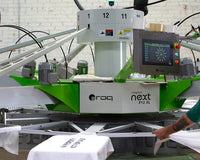Neck labels are a great way to show off a brand. Since it’s inside the shirt, it’s a popular and subtle way to give customers a branded experience without being too noisy. People look at neck tags for sizing, washing and care instructions, funny messages, and more. Creating your own neck label with your branding makes your garments feel more personal, both to the customer and to you. Wanna know how to pull it off? Here’s three steps to create and print custom neck labels.
STEP 1: CUT OUT THE TAG
First things first, you’ll need to cut or rip the existing tag off of the garment. Many shirts come with tearaway tags, which are easy to rip out. When looking for these shirts online, look in the product copy. They are usually advertised, so you’ll know which shirts to purchase.
If your shirt doesn’t have a tearaway tag, you’ll have to do things the old-school way. To cut the tag out, find the neck taping of the shirt. Fold the tag back and cut as close to the shirt as you can without actually cutting the shirt itself. Fold the neck taping back into place, and you’re good to go. You can’t even tell a tag was there in the first place. If you’re really picky (or your tag is still showing a bit after you’ve cut it out), you can rip out the tag with a seam ripper, then sew that seam back together.
STEP 2: DESIGN THE LABEL
The information that you need to add to your custom neck label varies based on the country you’re in. In North America, you’ll need three things: the full legal name of your company, the garment’s manufacturing location, and the fabric content. You can find both the garment manufacturing location and the fabric content on the original tag. If your logo already has the full legal name of your company, you’re already a step ahead. Don’t worry; you don’t have to create a new logo just for the tag. Simply adding your company’s name to the neck tag works great too.

Everything else that you add to the tag is optional. Printers usually add the size of the garment, washing or care instructions, and sometimes a funny message. No matter how much information you add to your tag, remember that it should fit in the tag area.While you can make the tag as large or small as you want, keep your label around 3-4 inches tall and wide as a guideline. That way, the customer can read it without grabbing their magnifying glass. While there isn’t a minimum font size you’ll have to stick to, it’s important that the font is large enough so the customer can read what you’ve printed.
If you’re printing shirts that will be sold in other countries, it’s important to create a neck label in the native language spoken in that country. If you’re selling clothing in Mexico, for example, the label should be printed in Spanish. While most countries do include English as a national language, you’ll need to create a neck label in the native language spoken. If you’re not sure what you need to include, do some research. Knowing the information regarding legality in printed neck labels is important, and can save you a lot of potential trouble.
STEP 3: PRINTING THE LABELS
The best placement for neck labels is ½”-1” below the collar seam. You can add these to your shirt a couple of ways: using a heat press or a screen printing press.
USING A HEAT PRESS
Many printers start out by heat pressing designs onto garments. If you’re using a heat press currently, then you may want to take this route. You can order custom heat transfers from many places to make your brand stand out, or create your own. This method is very quick and efficient. You can have hundreds of neck labels already printed or ordered, and press them onto shirts on demand.
To heat press a neck label, simply place the heat transfer on the neck area of the shirt. If you’d like, you can turn the shirt inside out for this, or use a hat press if you have one. Center the neck label over the collar area and heat press. It’s that simple. Peel the paper off of the transfer and you’re good to go!
Heat pressing neck labels is also more forgiving than screen printing them. If you misprint a neck label, you won’t be able to sell the shirt, no matter how much effort you put into the main design. You’ll have to start all over. With heat transfers, you can have as intricate a design as you’d like for the neck label all ready to go. All you need to do is heat press it to the shirt.
RELATED: HOW TO SCREEN PRINT MULTI-COLOR PLASTISOL HEAT TRANSFERS
SCREEN PRINTING
If you’d like to screen print your neck labels, plastisol ink is recommended. When using plastisol ink for neck labels, a soft hand additive is helpful so it isn’t scratchy on your customer’s neck. You’ll also want to print through a higher mesh count—230 or higher—because you want to lay down enough ink so the tag looks good, but not enough ink that the tag shows through the back of the shirt. A light or cool grey shade is the best color to use for neck tags with dark colored shirts. If you have a light colored shirt, go for a color that contrasts with the shirt color. Contrast ratio is important in neck tags, because the customer needs to be able to read the label. Printing light grey onto a grey shirt isn’t going to cut it.
PRO TIP: Plastisol ink is recommended for neck labels because plastisol ink sits on top of the shirt. If you printed a neck label with regular water-based ink, it will penetrate through the shirt and show the neck label through the back of the garment. You can print neck labels with a high-solids acrylic water-based ink. Follow the same recommendations when printing water-based neck labels as you would printing with plastisol.

To screen print neck labels, you can lay out multiple labels on one screen. Make sure you leave enough space between the labels to only print one at a time. If you only have a back clamp on your press, lay the labels out on your screen in landscape orientation (think “hamburger style”) so you can simply slide the screen over when it’s time to move up a size.
If you have side clamps, lay out your labels vertically (think “hot dog” style). This way, you can move the screen in and out according to which label you’re printing. Having all your neck label designs on one screen helps a ton, especially if you plan to keep using those labels for a long time.
RELATED: WHAT ARE SIDE CLAMPS AND WHY SHOULD YOU USE THEM?
PLATEN OPTIONS
There are a couple of different platens you can use to print neck labels. If you’re printing a high volume of neck labels, you’ll want to use a sleeve platen. Make a mark on the sleeve platen where you want the neck label to sit. Then, load the shirt and print the label. Taking the shirt off the platen without getting ink everywhere is a little trickier. To do this, keep the collar as wide as you can—without stretching the shirt—as you peel the neck of the shirt off the platen. If you have the tools, you can even make your own neck or sleeve platen.
If you’re only doing a small run of neck labels, you can use a regular platen. Turn the shirt inside out and load the shirt onto the platen with the back side facing up. Print the label and take it to the conveyor dryer, or cure it under your flash dryer. You won’t have to worry about getting ink in places it shouldn’t be.
PRO TIP: If you’re turning your shirt inside out to print neck labels, be very careful of the pallet adhesive, especially if you’ve been printing a ton and it’s hot and sticky. The adhesive can leave a gross glue residue on the front, and mess up the design you’ve already printed. Change out your pallet tape before printing neck labels, and use less adhesive to avoid this issue.

Printing neck labels is the perfect way to show off your brand and company without making too big of a statement. It increases brand visibility and adds a touch of credibility to every garment you send out of the shop. You may have customers return because they saw your branding on the neck label and wanted more. With more than one way to get these done, printing neck labels is perfect for any printer to show off their brand across the board.






